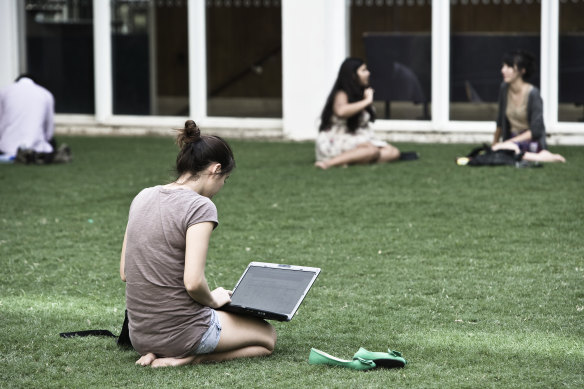This was published 1 year ago
Opinion
We must tighten graduate visa rules to reduce population pressures
By Brendan Coates and Trent Wiltshire
Australia is in a global arms race to attract the best international students to study and then stay permanently. But the post-study work rights we offer are too generous, offering false hope to many international graduates and adding to population pressures at a time when housing is in short supply.
Getting the best international students to stay permanently offers us big benefits. International graduates account for one-third of our permanent skilled migrant intake. Those students who are granted permanent skilled visas each year offer a $12 billion fiscal dividend over their lifetimes in Australia, more than double the profits universities reap each year from teaching international students.

Getting the best international students to stay permanently offers us big benefits.Credit: Louie Douvis
But many international students who graduate and stay here on “temporary graduate” visas struggle to pursue their chosen careers. Only half secure full-time employment, most work in low-skilled jobs, and half earn less than $53,300 a year.
Rising international student numbers and the limited permanent skilled visas on offer (137,100 in 2023-24) mean that a growing number of international graduates are stuck in visa limbo. Less than one-third of temporary graduate visa-holders now transition to permanent residency when their visa expires, down from two-thirds in 2014. One in three instead return to further study, mostly in cheaper vocational courses, to prolong their stay in Australia.
Encouraging so many international students to stay and struggle in Australia after they graduate is in no one’s interests. It damages the reputation of our international higher education sector and erodes public trust in our migration program. It’s unfair on those graduates who invest years in Australia with little prospect of securing permanent residency. And it adds to population and housing pressures for little gain.
The Albanese government has identified the growing number of “permanently temporary” visa-holders in Australia, including those on graduate visas, as a problem. Home Affairs Minister Clare O’Neil said recently: “We need to avoid policies and conditions that create permanent temporariness. This means clearer pathways for the skilled workers we need, and clarity for the migrants that have less of a prospect of becoming a permanent resident.”
But despite these stated aims, the Albanese government at last year’s Jobs and Skills Summit increased the length of temporary visas offered to international graduates: to up to four years for many bachelor’s graduates; five years for masters graduates; and six years for PhDs. Some students studying in the regions can now stay and work in Australia on a temporary visa for up to eight years after they graduate.
It’s a big reason why the number of temporary graduate visa-holders in Australia is expected to nearly double to about 370,000 by 2030. Unless the government lifts the size of the permanent migration program, which seems unlikely, many more graduates will be stuck in visa limbo in future, with even worse prospects of ever securing permanent residency.
The government needs to reverse course, and quickly. Here’s what it needs to do.
First, Australia should offer shorter post-study work visas to international graduates. Most graduates that succeed long-term in Australia find a good job within their first two years.
Visa extensions for graduates with degrees in nominated areas of shortage, and for living in the regions, should be scrapped. Instead, graduates should be eligible for an extension to their visa only if they earn at least $70,000 a year, a good sign that they’ll eventually secure a permanent visa.
And a new “exceptionally talented graduate” permanent visa should be offered to the most talented international students immediately upon graduation.
Winding back the length of post-study work rights offered to international graduates would slow population growth and ease the pressure on the housing market. Grattan Institute’s proposed visa reforms would see about 140,000 fewer international students and graduates in Australia by 2030, compared to if existing policies stay. This would reduce the number of extra homes Australia needs to build by about 60,000 by the end of the decade.
Second, Australia should reform existing skilled visas to encourage talented graduates to stay, and to encourage employers to hire them.
Third, Australia should do more to help international graduates to thrive here. The government should launch a campaign designed to change employer attitudes about new international graduates, and public sector graduate programs should accept international graduates. Universities should give more support to international graduates to help them build careers in Australia.
These reforms would ensure Australia continues to attract the best international students, and help the best graduates to stay permanently – while reducing the number of graduates we leave in limbo.
The Albanese government has talked a big game about stopping migrants getting stuck in visa limbo. But when it comes to international graduates, its actions haven’t matched its words.
Brendan Coates and Trent Wiltshire are co-authors of the new Grattan Institute report, Graduates in limbo: International student visa pathways after graduation.
Get a weekly wrap of views that will challenge, champion and inform your own. Sign up for our Opinion newsletter.